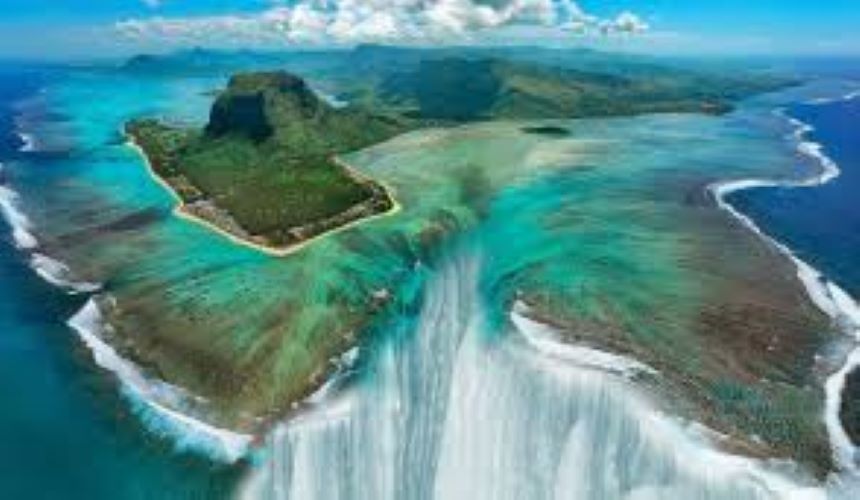Denmark Strait Cataract: World’s Largest Underwater waterfall on Earth

The Denmark Strait cataract, an extraordinary underwater phenomenon, holds the title of the largest waterfall on Earth. Nestled in the deep waters between Iceland and Greenland, this submarine cascade plunges an astonishing 11,500 feet (3,500 meters) from its summit to the ocean floor. Its vertical drop of 6,600 feet (2,000 meters) far surpasses that of Angel Falls, the tallest waterfall on land, which stands at just over 3,200 feet (979 meters). Despite its immense size, the Denmark Strait cataract remains hidden beneath the waves, making it undetectable from the surface. This article explores the formation, scale, and significance of this remarkable underwater waterfall.
Formation During the Ice Age
The Denmark Strait cataract was formed during the last Ice Age, approximately 17,500 to 11,500 years ago. During this period, glacial activity shaped the seabed, creating a channel that now directs cold water from the Nordic Seas into the Irminger Sea. This geological process plays a crucial role in the thermohaline circulation, a global system of ocean currents that regulates climate and marine ecosystems.
Professor Anna Sanchez Vidal from the University of Barcelona has studied this phenomenon extensively. She notes that while the effects of the cataract are not visible at the ocean’s surface, temperature and salinity data provide clear evidence of its activity. The cold, dense water that flows down the cataract contributes to the overall dynamics of ocean currents. This process is vital for maintaining the balance of marine life and the global climate. Understanding the formation of the Denmark Strait cataract helps scientists grasp the historical changes in our planet’s climate and ocean systems.
Scale and Dynamics of the Waterfall
The Denmark Strait cataract stretches approximately 300 miles (480 kilometers) across the width of the strait. Despite its vast scale, the water flows at a relatively modest speed of 1.6 feet per second (0.5 meters per second). This is a stark contrast to the impressive 100 feet per second (30.5 meters per second) recorded at Niagara Falls. Marine geosystems expert Mike Clare describes the gradient of the cataract as a “relatively low slope,” which contributes to its unique characteristics.
The cataract serves as a critical gateway for polar waters moving southward. Its flow influences global ocean circulation patterns, which are essential for regulating climate and weather systems around the world. Although the Denmark Strait cataract lacks the dramatic visuals associated with terrestrial waterfalls, its significance cannot be overstated. It plays a vital role in the Earth’s climate system, affecting everything from marine biodiversity to weather patterns.
Significance in Global Ocean Circulation
The Denmark Strait cataract is not just an impressive geological feature; it is also a key player in the global ocean circulation system. The cold, dense water that cascades down the cataract contributes to the formation of deep ocean currents. These currents are crucial for transporting heat and nutrients across the globe, influencing marine ecosystems and climate.
The thermohaline circulation, often referred to as the “global conveyor belt,” relies on the movement of water masses like those found in the Denmark Strait. As the cold water sinks, it helps drive the circulation that connects the world’s oceans. This process is essential for maintaining the balance of marine life and regulating the Earth’s climate.
Researchers continue to study the Denmark Strait cataract to better understand its impact on ocean dynamics. By examining temperature and salinity data, scientists can gain insights into how this underwater waterfall influences global climate patterns. The findings could have significant implications for predicting future climate changes and understanding the health of our oceans.
The Denmark Strait cataract is a remarkable natural wonder that plays a vital role in our planet’s oceanic and climatic systems. Its hidden grandeur and significance make it a subject of ongoing scientific interest and exploration.
Observer Voice is the one stop site for National, International news, Sports, Editor’s Choice, Art/culture contents, Quotes and much more. We also cover historical contents. Historical contents includes World History, Indian History, and what happened today. The website also covers Entertainment across the India and World.
Follow Us on Twitter, Instagram, Facebook, & LinkedIn

